

Paul Eduard Crodel (7 September 1862, Cottbus - 28 July 1928, Dietramszell) was a German landscape painter and a co-founder of the Munich Secession. He was sometimes known as "Schnee-und-Regen-Crodel" (Snow-and-Rain Crodel).


Paul Eduard Crodel (7 September 1862, Cottbus - 28 July 1928, Dietramszell) was a German landscape painter and a co-founder of the Munich Secession. He was sometimes known as "Schnee-und-Regen-Crodel" (Snow-and-Rain Crodel).
He came from a family of artists, dating back to the late 15th century. From 1882 to 1885, he studied at the Grand-Ducal Saxon Art School, Weimar, with Woldemar Friedrich and Theodor Hagen. Then, he spent three years at the Academy of Fine Arts, Karlsruhe, in the studio of Hermann Baisch. Upon completing his studies, he moved to Munich and held several showings at the Glaspalast. In 1892, he was involved in establishing the Munich Secession.
He observed the practice of painting en plein aire and became involved in the private academy, in the suburbs north of Munich, that was operated by Bernhard Buttersack. His fellow students there included Christian Landenberger, Otto Ubbelohde and Wilhelm Ludwig Lehmann . [1] Later, possibly at the suggestion of Lehmann, who was Swiss, he explored the Alps in the vicinity of Isny and spent the winter of 1907–08 in Switzerland.
In 1909, he was called to serve on the commission of the Venice Biennale. He exhibited there that same year and again in 1910. He was on the jury of the Munich Secession in 1911 [2] and was also a member of the Deutscher Künstlerbund; dating from their first joint exhibition with the Secession in 1904. [3]
He died of a stroke, at the age of sixty-six, near Dietramszell and was interred at the Alter Zwölf-Apostel-Kirchhof in Berlin with other members of his family. [4]
His daughter, Erna Dinklage also became a painter, under his tutelage, and he promoted the career of his nephew, Charles Crodel.
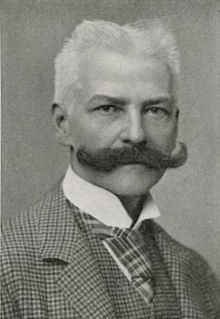
Albert von Keller was a German painter of Swiss ancestry. He specialized in portraits and indoor scenes. Female figures are a prominent feature of his work.

Hermann Max Pechstein was a German expressionist painter and printmaker and a member of the Die Brücke group. He took part in the Western Front during World War I and his art was classified as Degenerate Art by the Nazis. More than 300 paintings were removed from German Museums during the Nazi era.

Charles Crodel was a German painter and stained glass artist.

Karl Christian Ludwig Hofer or Carl Hofer was a German expressionist painter. He was director of the Berlin Academy of Fine Arts.

Bruno Paul was a German architect, illustrator, interior designer, and furniture designer.

The Berlin Secession was an art movement established in Germany on May 2, 1898. Formed in reaction to the Association of Berlin Artists, and the restrictions on contemporary art imposed by Kaiser Wilhelm II, 65 artists "seceded," demonstrating against the standards of academic or government-endorsed art. The movement is classified as a form of German Modernism, and came on the heels of several other secessions in Germany, including Jugendstil and the Munich Secession.
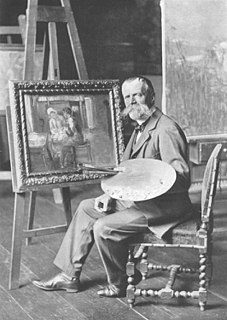
Fritz von Uhde was a German painter of genre and religious subjects. His style lay in-between Realism and Impressionism, he was once known as "Germany's outstanding impressionist" and he became one of the first painters to introduce plein-air painting in his country.

Friedrich August von Kaulbach was a German portraitist and historical painter.
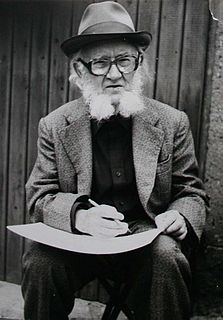
Otto Müller was a German painter and graphic designer.
Eduard Bargheer was a German painter and printmaker. His early oeuvre had a close affinity to Expressionism.

Heinrich Knirr was an Austrian-born German painter, known for genre scenes and portraits, although he also did landscapes and still-lifes. He is best-known for creating the official portrait of Adolf Hitler for 1937 and is the only artist known to have painted Hitler from life.

Maximilian Albert Josef Liebenwein was an Austrian-German painter, graphic artist and book illustrator, in the Impressionist and Art Nouveau styles. He spent significant time in Vienna, Munich and Burghausen, Altötting, and took an active part in the artistic community in all three places. He was an important member of the Vienna Secession, becoming its vice-president, and exhibiting with the group many times.

Christian Adam Landenberger was a German Impressionist painter and a Professor at the State Academy of Fine Arts Stuttgart. He is especially known for his landscapes.

Hans Tichy was an Austrian artist and a professor at the Academy of Fine Arts, Vienna.

Rudolf Otto von Ottenfeld was an Austrian military painter, a founding member of the Vienna Secession and a professor at the Academy of Fine Arts, Prague.

The Munich Secession was an association of visual artists who broke away from the mainstream Munich Artists' Association in 1892, to promote and defend their art in the face of what they considered official paternalism and its conservative policies. They acted as a form of cooperative, using their influence to assure their economic survival and obtain commissions. In 1901, the association split again when some dissatisfied members formed the group Phalanx. Another split occurred in 1913, with the founding of the "New Munich Secession".
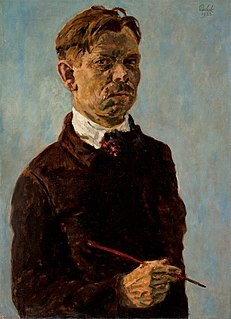
Bernhard Wilhelm Maria Pankok was a German painter, graphic artist, architect, and designer. His works are characterized by the transition between Art Nouveau and the International Style. His furniture and book design, such as the catalog for the German section of the Exposition Universelle (1900) in Paris, have garnered him the most recognition.

Fritz Osswald was a Swiss painter, member of the Munich Secession and of the Darmstadt Artists' Colony.
Charles Johann Palmié (1863-1911) is a pointillist/Neo-Impressionist painter noted for being a founding member with Wassily Kandinsky in 1909 of NKVM which prefigured Der Blaue Reiter, the first modernist secession which is regarded as a forerunner and pathfinder for Modern art in 20th-century Germany and for painting with Claude Monet in Giverny, France in 1906.
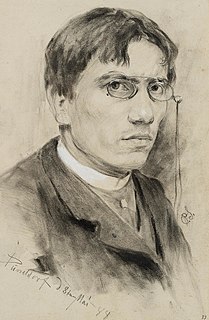
Paul Alfred Schroeter or Schröter was a German painter and etcher.